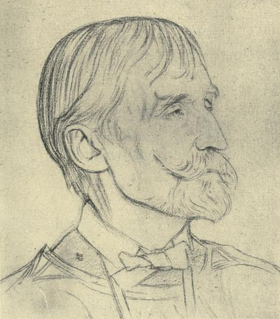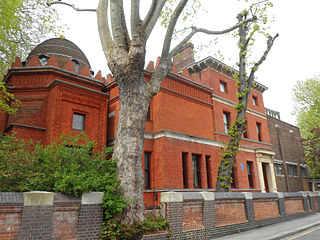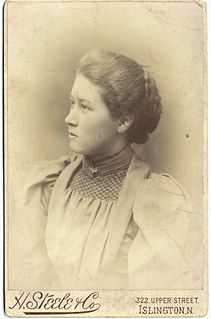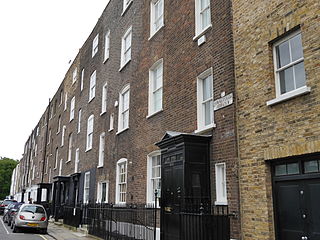
William Morris was a British textile designer, poet, novelist, translator and socialist activist associated with the British Arts and Crafts Movement. He was a major contributor to the revival of traditional British textile arts and methods of production. His literary contributions helped to establish the modern fantasy genre, while he helped win acceptance of socialism in fin de siècle Great Britain.

Hammersmith is a district of west London, England, located 4.3 miles (6.9 km) west-southwest of Charing Cross. It is the administrative centre of the London Borough of Hammersmith and Fulham, and identified in the London Plan as one of 35 major centres in Greater London.

Chipping Campden is a small market town in the Cotswold district of Gloucestershire, England. It is notable for its elegant terraced High Street, dating from the 14th century to the 17th century.

William Richard Morris, 1st Viscount Nuffield, was an English motor manufacturer and philanthropist. He was the founder of Morris Motors Limited and is remembered as the founder of the Nuffield Foundation, the Nuffield Trust and Nuffield College, Oxford, as well as being involved in his role as President of BUPA in creating what is now Nuffield Health. He took his title from the village of Nuffield in Oxfordshire, where he lived.

Thomas James Cobden-Sanderson was an English artist and bookbinder associated with the Arts and Crafts movement.

The legacy of a family's passion for Victorian art and design, Wightwick Manor is a Victorian manor house located on Wightwick Bank, Wolverhampton, West Midlands, England. Owned by the National Trust since 1937, the Manor and its grounds are open to the public. It is one of only a few surviving examples of a house built and furnished under the influence of the Aesthetic movement and Arts and Crafts movement. The house is in a grand version of the half-timbered vernacular style, of which the most famous original example is Little Moreton Hall over 40 miles to the north, in Cheshire.

Standen is an Arts and Crafts house located to the south of East Grinstead, West Sussex, England. The house and its surrounding gardens belong to the National Trust and are open to the public. It is a Grade I listed building.

Red House is a significant Arts and Crafts building located in the town of Bexleyheath in Southeast London, England. Co-designed in 1859 by the architect Philip Webb and the designer William Morris, it was created to serve as a family home for the latter, with construction being completed in 1860.

Jane Morris was an English embroiderer in the Arts & Crafts Movement and artists' model who embodied the Pre-Raphaelite ideal of beauty. She was a model and muse to her husband William Morris and to Dante Gabriel Rossetti. Her sister was the embroiderer and teacher Elizabeth (Bessie) Burden.

Morris, Marshall, Faulkner & Co. (1861–1875) was a furnishings and decorative arts manufacturer and retailer founded by the artist and designer William Morris with friends from the Pre-Raphaelites. With its successor Morris & Co. (1875–1940) the firm's medieval-inspired aesthetic and respect for hand-craftsmanship and traditional textile arts had a profound influence on the decoration of churches and houses into the early 20th century.

The Leighton House Museum is an art museum in the Holland Park area of the Royal Borough of Kensington and Chelsea in west London.

West Kensington, formerly North End, is an area in the ancient parish of Fulham, in the London Borough of Hammersmith and Fulham, England, 3.4 miles (5.5 km) west of Charing Cross. It covers most of the London postal area of W14, including the area around Barons Court tube station, and is defined as the area between Lillie Road and Hammersmith Road to the west, Fulham Palace Road to the south, Hammersmith to the north and West Brompton and Earl's Court to the east. The area is bisected by the major London artery the A4, locally known as the Talgarth Road. Its main local thoroughfare is the North End Road.

The Doves Press was a private press based in Hammersmith, London. During nearly seventeen years of operation, the Doves Press produced notable examples of twentieth-century typography. A distinguishing feature of its books was a specially-devised font, known variously as the Doves Roman, the Doves Press Fount of Type, or simply the Doves type.

Coleton Fishacre is a property consisting of a 24-acre (97,000 m2) garden and a house in the Arts and Crafts style, near Kingswear in Devon, England. The property has been in the ownership of the National Trust since 1982.

Sir Emery Walker was an English engraver, photographer and printer. Walker took an active role in many organisations that were at the heart of the Arts and Crafts movement, including the Art Workers Guild, the Society for the Protection of Ancient Buildings, and the Arts and Crafts Exhibition Society.
John Brandon-Jones was a British architect. His work was heavily influenced by the Arts and Crafts movement, of which he was a noted architectural historian.

Mary Annie Sloane was an English artist associated with the Arts and Crafts movement.

Edward Ernest Hollamby was an English architect, town planner, and architectural conservationist. Known for designing a number of modernist housing estates in London, he had also achieved notability for his work in restoring the Red House, the Arts and Crafts building in Bexleyheath, Southeast London, which was designed by William Morris and Philip Webb in the year 1859.

Hammersmith Terrace is a street of listed, brick-built houses in Hammersmith, west London. All of the seventeen houses in the terrace are Grade II listed, except No. 7 which is Grade II*. The street was built in about 1770 and has been home to several notable artists.

Julia Sarah Anne Cobden-Sanderson was an English socialist, suffragette and vegetarian.





















